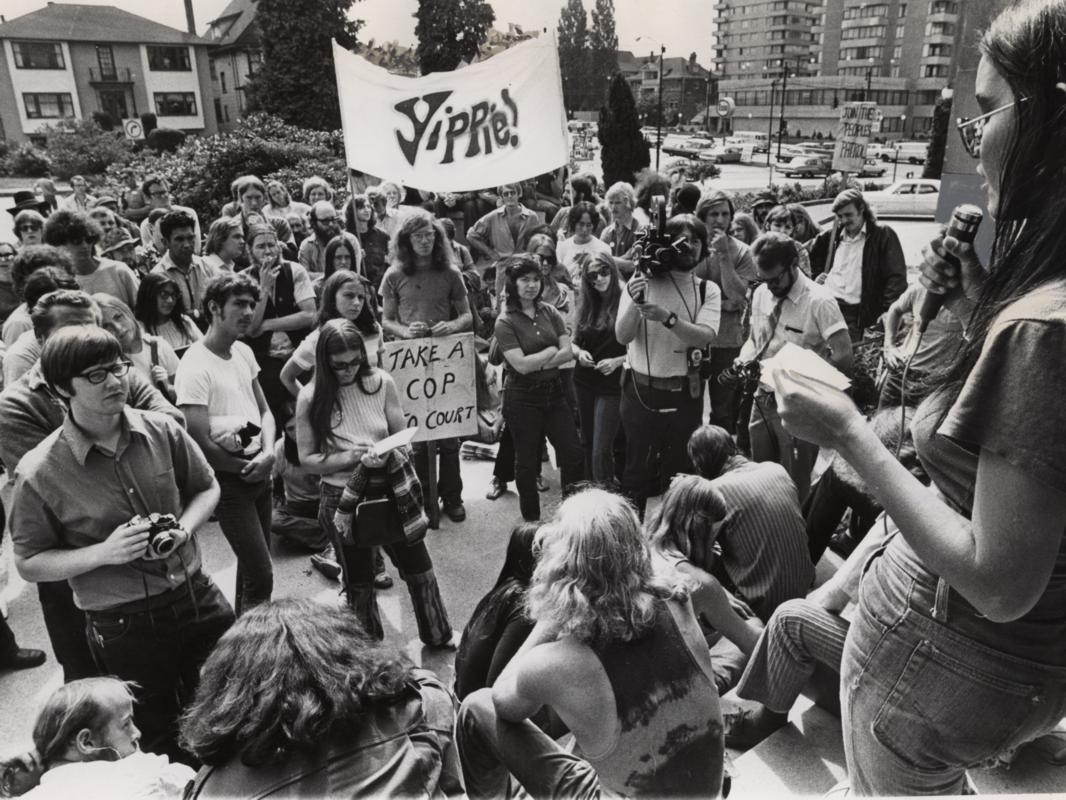 |
| Yippies |
On 31 December 1967, at a party hosted by Abbie and Anita Hoffman and attended by Jerry Rubin, Nancy Kurshan, and Paul Krassner, the movement known as Yippie!—the Youth International Party (YIP)—was born.
Guided by Hoffman and Rubin, the clown-princes of “the Movement” during the Vietnam era, the Yippies attempted, through myth, media savvy, and guerrilla theater to bind the hippie counterculture and the politicized New Left into a powerful youth movement capable of creating an alternative U.S. society.
By building on their earlier media attention-grabbing protest events, such as the August 1967 episode of money throwing and burning at the New York Stock Exchange and the October 1967 National Mobilization to End the War in Vietnam march on the Pentagon where the duo took part in an attempted exorcism and levitation of the building, Hoffman and Rubin attempted to use the popular press to publicize YIP and garner support for their ideological views.
  |
The Yippies were one of a number of late 1960s countercultural movements who not only viewed the establishment as amounting to a conspiracy, but also self-consciously styled themselves as a counterconspiracy.
The Yippies’ first major media event took place on 27 February 1968, when members of the group “raided” the campus of the State University of New York (SUNY)–Stoney Brook mimicking a recent on-campus drug-bust.
Following this action, on 22 March 1968, the Youth International Party held a “Yip-In” at New York City’s Grand Central Station. Six thousand potential Yippies congregated amidst incense and balloons—so did officers of the New York Police Department.
When a demonstrator removed the hands from a large clock, the police attacked, making fifty arrests and throwing one demonstrator through a plate glass door. This melee, however, was only a prelude to the major summer event the Yippies had planned—the Festival of Life.
Coinciding with the August 1968 Democratic National Convention (DNC), the Yippie Festival of Life sought to bring tens of thousands of people to Chicago to launch a demonstration that would end the war in Vietnam and usher in a new, free society.
The Yippies aimed to counterpose what they saw as the political “convention of death,” and they planned to include a huge rock-folk festival, numerous theater performances, educational workshops, and a “constitutional convention.”
Chicago Mayor Richard Daley, who had promised to bring local, state, and federal powers to bear against anyone attempting to disrupt the convention, thwarted YIP efforts at achieving the full aims of the festival. Instead, Daley’s tactics forced confrontations between his police force and those who had come to protest the DNC.
Despite repressive government tactics, the Yippies succeeded in nominating a pig, “Pigasus,” for president, providing a brief rock concert, causing an LSD scare by threatening to lace the Chicago water supply with the drug, and providing movement workshops on guerrilla theater and protest maneuvers.
The events surrounding the convention drew to a climax when, on the night of 29 August, a “police riot” broke out when Daley’s lawmen violently assaulted protesters, journalists, and bystanders alike. Hoffman and Rubin would later be indicted on conspiracy charges, for their activities during the convention, as part of the Chicago 7 trial.
The Yippies continued to garner media attention within and outside the Movement for the remainder of the 1960s and into the 1970s. At the 1972 Democratic National Convention, held in Miami Beach, Florida, the younger faction of the Youth International Party, the “Zippies” (or Zeitgeist International Party) broke with the older YIP members.
Hoffman and Rubin, who conditionally supported the peace platform of Democratic presidential candidate George McGovern, were seen as establishment “sell-outs” by the younger YIP faction, whereas the older Yippies objected to the Zippies’ outrageous street comedy, which they viewed as overly cruel satire.
As the power and momentum of the Movement declined, so did the visibility of the Yippies. Beginning in the 1970s, YIP published the Yipster Times (later renamed Overthrow) and the Youth International Party Line or YIPL (later known as TAP [Technological American Party or Technological Assistance Program]) magazine.
By the 1980s, the Yippies were best known for their “smoke-ins” (which developed into annual “pot parades” promoting the legalization of marijuana), crank phone call wars with Yippie enemies, and maintenance of their protest and demonstration staging point, the Yippie loft—an apartment in New York City’s East Village that has served as the group’s headquarters since 1973.